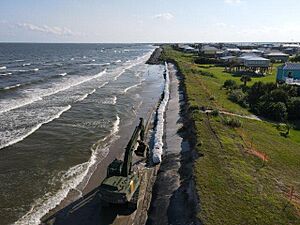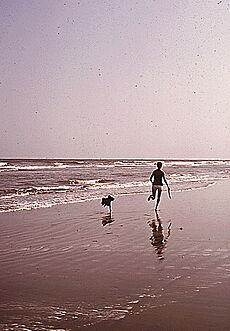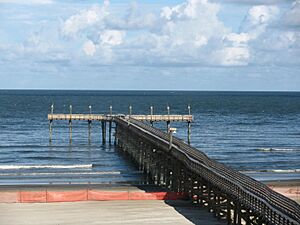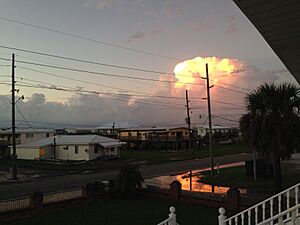Grand Isle, Louisiana facts for kids
Quick facts for kids
Grand Isle, Louisiana
|
||
|---|---|---|
| Town of Grand Isle | ||
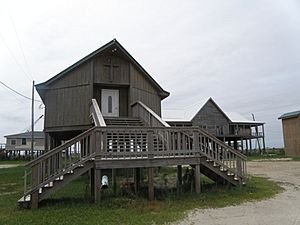
Lighthouse Christian Fellowship Church
|
||
|
||
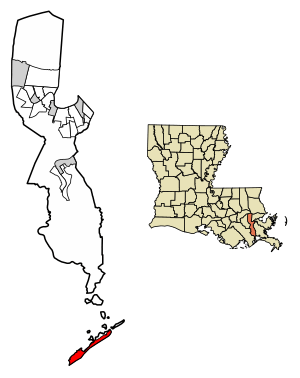
Location of Grand Isle in Jefferson Parish
|
||

Location of Louisiana in the United States
|
||
| Country | United States | |
| State | Louisiana | |
| Parish | Jefferson | |
| Area | ||
| • Total | 8.17 sq mi (21.17 km2) | |
| • Land | 6.40 sq mi (16.59 km2) | |
| • Water | 1.77 sq mi (4.58 km2) | |
| Elevation | 7 ft (2 m) | |
| Population
(2020)
|
||
| • Total | 1,005 | |
| • Rank | JE: 6th | |
| • Density | 156.93/sq mi (60.59/km2) | |
| Time zone | UTC-6 (CST) | |
| • Summer (DST) | UTC-5 (CDT) | |
| ZIP Code |
70358
|
|
| Area code(s) | 985 | |
| FIPS code | 22-30830 | |
Grand Isle is a small town in Jefferson Parish, Louisiana. It is located on a barrier island in the Gulf of Mexico. This island sits where Barataria Bay meets the Gulf. Grand Isle is considered part of the New Orleans area, but it is not directly connected to the city's main urban area.
In 2020, about 1,005 people lived in Grand Isle. This number was a bit lower than the 1,296 people who lived there in 2010.
The main road in Grand Isle is Louisiana Highway 1 (LA 1). This highway starts at the seaside and stretches for about 436 miles (702 km) to the northwest corner of Louisiana. The only way to drive to Grand Isle is by using the causeway on LA 1. The main government offices for Jefferson Parish are about 95 miles (153 km) away.
Contents
History of Grand Isle
Grand Isle has often been hit by strong storms called hurricanes. Since 1877, the town has been affected by tropical storms or hurricanes about every 2.68 years. It gets a direct hit, on average, every 7.88 years. Here are some of the more serious storms it has faced.
In 1860, a 6-foot (1.8 m) storm surge and strong winds completely destroyed the island. In 1893, a huge 16-foot (4.9 m) storm surge hit Grand Isle. Another 16-foot (4.9 m) storm surge struck in 1909. A very powerful Category 4 hurricane caused a lot of damage on September 29, 1915. In 1947, a 3.6-foot (1.1 m) storm surge hit. In 1956, Hurricane Flossy also damaged the island.
Hurricane Betsy in September 1965 and Tropical Storm Frances in 1998 covered the entire island with water. On September 26, 2002, Hurricane Isidore hit Grand Isle. Soon after, Hurricane Lili passed nearby, causing more damage. Hurricane Cindy hit Grand Isle directly on July 5, 2005. Even though it mainly caused power outages and beach erosion, its strength surprised residents.
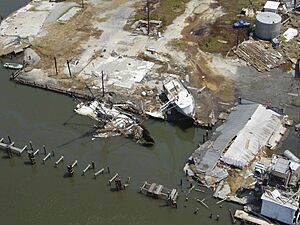

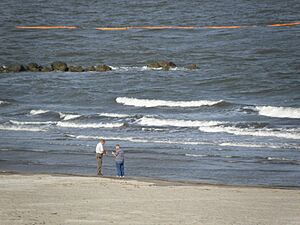
Hurricane Katrina hit Grand Isle for two days, August 28–29, 2005. It destroyed or damaged many homes and camps. Katrina's water surge reached 5 feet (1.5 m) in Grand Isle. Big waves badly damaged the only bridge connecting the island to the mainland. Less than a month later, Hurricane Rita also affected Grand Isle. By mid-October, many businesses on the island were open again.
Hurricane Gustav reached the shore west of the island on September 1, 2008. It hit Grand Isle with winds of 105 miles per hour (169 km/h). The storm surge from Gustav caused less damage than Katrina. This was partly because the most fragile buildings had already been destroyed by Katrina. New building rules also prevented rebuilding weak structures.
Hurricane Ike passed far south of the island on September 11, 2008. This happened while crews were fixing power and levee damage from Gustav. Some parts of LA 1 west of the island were covered by 1 foot (0.30 m) of water. Wind gusts reached 50 miles per hour (80 km/h).
Hurricane Ida hit the area on August 29, 2021. This was 16 years after Hurricane Katrina. Ida caused widespread damage. Reports said that all structures in Grand Isle were damaged. About 40–50 percent of buildings were completely destroyed. Almost all the town's power poles were bent or collapsed. The power company, Entergy, decided to rebuild the island's power grid completely. They made it stronger instead of just repairing it.
Protecting Grand Isle's Coast
In 1998, Louisiana and its partners started a project called Coast 2050. This project aims to restore the coast. It is a $14 billion plan over 50 years. It includes about 77 projects to create a healthy coastal ecosystem. Grand Isle is at the mouth of Barataria Bay, which was a top priority for restoration.
In 2009, the National Oceanic and Atmospheric Administration gave $3 million. This money was for restoring a protective marsh. This marsh helps shield the island from flooding. It also provides better hurricane protection. This helps preserve a key barrier island.
Also in 2009, the Nature Conservancy received $4 million. This was for their Grand Isle shoreline project. They created four miles of oyster reefs along the beach. These reefs grow into 2 to 3-foot (0.61 to 0.91 m) high oyster reefs. They protect the shore and create homes for fish. These oysters also help filter the water.
After the Deepwater Horizon Oil Spill, many groups helped. In 2011, they planted over 1,600 mangroves in Grand Isle State Park. Mangroves help stabilize the sand. They also provide homes for wildlife, especially pelicans.
In 2012, volunteers helped restore beach dunes at Grand Isle State Park. This was after Hurricane Isaac. They installed dune fences and planted over 12,000 dune grass plants. This helps make the beach more stable.
Geography of Grand Isle
Grand Isle covers about 7.8 square miles (20.2 km2) in total. About 6.1 square miles (15.8 km2) is land. The remaining 1.7 square miles (4.4 km2) is water.
Climate in Grand Isle
Grand Isle has a humid subtropical climate. This means it has mild winters. Summers are long, hot, and humid.
| Climate data for Grand Isle, Louisiana | |||||||||||||
|---|---|---|---|---|---|---|---|---|---|---|---|---|---|
| Month | Jan | Feb | Mar | Apr | May | Jun | Jul | Aug | Sep | Oct | Nov | Dec | Year |
| Record high °F (°C) | 83 (28) |
82 (28) |
86 (30) |
91 (33) |
95 (35) |
99 (37) |
100 (38) |
100 (38) |
97 (36) |
94 (34) |
86 (30) |
82 (28) |
100 (38) |
| Mean daily maximum °F (°C) | 63 (17) |
66 (19) |
71 (22) |
77 (25) |
84 (29) |
88 (31) |
90 (32) |
90 (32) |
87 (31) |
79 (26) |
72 (22) |
65 (18) |
78 (25) |
| Daily mean °F (°C) | 54 (12) |
57 (14) |
62 (17) |
69 (21) |
77 (25) |
81 (27) |
83 (28) |
83 (28) |
81 (27) |
72 (22) |
64 (18) |
56 (13) |
70 (21) |
| Mean daily minimum °F (°C) | 44 (7) |
47 (8) |
53 (12) |
60 (16) |
69 (21) |
74 (23) |
76 (24) |
76 (24) |
74 (23) |
63 (17) |
56 (13) |
47 (8) |
62 (16) |
| Record low °F (°C) | 14 (−10) |
12 (−11) |
16 (−9) |
35 (2) |
48 (9) |
50 (10) |
65 (18) |
62 (17) |
52 (11) |
34 (1) |
24 (−4) |
10 (−12) |
10 (−12) |
| Average precipitation inches (mm) | 5.1 (130) |
4.9 (120) |
4.7 (120) |
2.2 (56) |
4.5 (110) |
7.2 (180) |
8.0 (200) |
7.6 (190) |
6.2 (160) |
4.7 (120) |
3.4 (86) |
4.7 (120) |
63.2 (1,592) |
| Source: The Weather Channel (Monthly Averages) | |||||||||||||
Coastal Protection Efforts
In 2010, the United States Army Corps of Engineers built a special levee. This artificial levee is along the island's southern coast. It cost $52 million. The levee is 7.7 miles (12.4 km) long, 13 feet (4.0 m) tall, and 80 feet (24 m) wide. The middle of the levee has a large tube filled with sand. This tube is why it's called the "Burrito Levee." The levee has been damaged by several storms. These include Tropical Storm Cristobal and Hurricane Zeta in 2020, and Hurricane Ida in 2021.
People of Grand Isle
| Historical population | |||
|---|---|---|---|
| Census | Pop. | %± | |
| 1960 | 2,074 | — | |
| 1970 | 2,236 | 7.8% | |
| 1980 | 1,982 | −11.4% | |
| 1990 | 1,455 | −26.6% | |
| 2000 | 1,541 | 5.9% | |
| 2010 | 1,296 | −15.9% | |
| 2020 | 1,005 | −22.5% | |
| U.S. Decennial Census | |||
| Race | Number | Percentage |
|---|---|---|
| White (non-Hispanic) | 929 | 92.44% |
| Black or African American (non-Hispanic) | 2 | 0.2% |
| Native American | 15 | 1.49% |
| Asian | 6 | 0.6% |
| Other/Mixed | 23 | 2.29% |
| Hispanic or Latino | 30 | 2.99% |
In 2000, there were 1,541 people living in Grand Isle. There were 622 households and 436 families. About 29.6% of households had children under 18. Most households (54.2%) were married couples.
By 2020, the population was 1,005 people. There were 330 households and 184 families. Most residents (92.44%) were non-Hispanic white.
Arts and Culture
Fishing is a big part of life in Grand Isle. More than 280 types of fish live in the nearby waters. In 1928, the yearly Grand Isle Tarpon Rodeo started. This fishing tournament is now one of the best saltwater fishing events in the United States. It attracts over 15,000 people each year.
The island also has nice beaches. Grand Isle State Park is on the east end of the island. It is the only state-owned beach on the Louisiana Gulf Coast. The beach is a popular spot for people from South Louisiana. It is also one of the few places in Louisiana where people surf. A local surf club started in 2017. They rent surfboards and give lessons.
The Coast Guard Station Grand Isle is also located on the eastern end of the island.
Grand Isle Migratory Bird Festival
The Grand Isle Migratory Bird Festival happens every April. It started in 1997. Nature groups created it to protect and restore the island's chenier habitat. The festival helps people learn about and see migratory birds. It also teaches about the plants the birds use.
The festival used to be one day. Now, it is a three-day event because it is so popular. During the festival, there are many tours. Experienced guides teach new bird watchers how to find and identify birds. They also explain the island's environment. Other tours teach about native plants. Some of these plants are food for birds and people. The festival also has bird banding demonstrations. There are also seminars on choosing binoculars and fun games.
Grand Isle is a barrier island with marshes, beaches, and chenier forests. These areas attract many migratory birds. The hardwood forests are important resting spots for birds. Birds stop here before or after flying across the Gulf of Mexico. This happens during both fall and spring migrations. The festival is held when spring migrants return from their winter homes.
What is a Chenier Habitat?
Chenier habitats are special areas found along the southeastern coasts of Louisiana. They are part of the Chenier Plain. This plain stretches from Vermilion Bay, Louisiana to East Bay, Texas. Long ago, there were about 500,000 acres of chenier habitat. Today, only about 5,000 to 10,000 acres remain.
Chenier forests have hardwood trees like oaks and hackberries. They also have other plants like mulberry and green ash. These trees grow on slightly raised ridges. These ridges formed from sediment left by the Mississippi River. They can be 3 to 15 feet (1 to 4.6 m) high and 100 to 1,500 feet (30 to 457 m) wide. Because they are higher, chenier forests allow hardwood trees to grow. These trees support many migratory birds. They also act as a barrier. They stop saltwater from entering marshes during storms.
Chenier forests give migratory birds a place to rest. They stop before or after flying across the Gulf of Mexico. For some birds, this habitat is vital for breeding. Studies show that food is a main reason birds stop here. Birds often stop more frequently near the coast. More trees in a forest mean more insects and fruit. Migratory birds use forest cover to find good food sources. This helps them prepare for their long journey.
Grand Isle Birding Trail
The birding trails in Grand Isle cover almost sixty acres. They include marsh and chenier habitats. The trails are divided into six sections. The Louisiana Nature Conservancy and the Grand Isle Community Development Team manage them. Most of the trails are on land given by the Nature Conservancy or local owners. Sometimes, the chenier habitat extends onto private land. But because the bird festival is so popular, landowners usually let bird watchers visit. Some residents even put up "Bird Friendly" signs.
The Grilleta Tract was given by Xavier Grilleta in 1998. It is ten acres. In 2001, three more acres were added next to it. This tract is mostly chenier habitat. It is considered the main part of the Grand Isle Birding Trail. This forest is one of only two untouched chenier forests on the island. It has live oaks, some over 125 years old. It also has mulberry, black willow, and red bay trees.
The Grand Isle Port Commission Tract is about 22 acres. It is on the western part of the island. A 280-foot (85 m) boardwalk lets people access the salt marsh tidal ponds. Bird watchers can see many types of birds here. These include songbirds, birds of prey, and wading birds. The second largest forest area is called the Sureway Woods. It combines the Maples tract and the Landry-Leblanc tract. Together, they make up twenty acres of chenier forest.
The other two tracts are Cemetery Woods and the Govan Tract. Cemetery Woods is about four and a half acres. It has old trees over 125 years old, like the Grilleta Tract. This property also has salt flats and marshland. These areas attract ducks, moorhens, and other wading birds. The Govan Tract was given to the Nature Conservancy in 2003. It is only half an acre. But it has many live oaks, hackberries, and other plants. These attract birds like painted buntings and warblers during migration.
Besides the Grand Isle Birding Trail, you can also see marine birds. These include gulls, terns, and pelicans. You can spot them from Grand Isle State Park. This park is at the northeast end of the island.
Education in Grand Isle
Grand Isle is part of the Jefferson Parish Public Schools system. The Grand Isle School teaches students from pre-kindergarten to 12th grade.
The Grand Isle Library is a small public library. It helps local residents and visitors. The new Grand Isle Library opened on November 14, 2012.
Delgado Community College serves the Jefferson Parish area.
See also
 In Spanish: Grand Isle (parroquia de Jefferson, Luisiana) para niños
In Spanish: Grand Isle (parroquia de Jefferson, Luisiana) para niños



